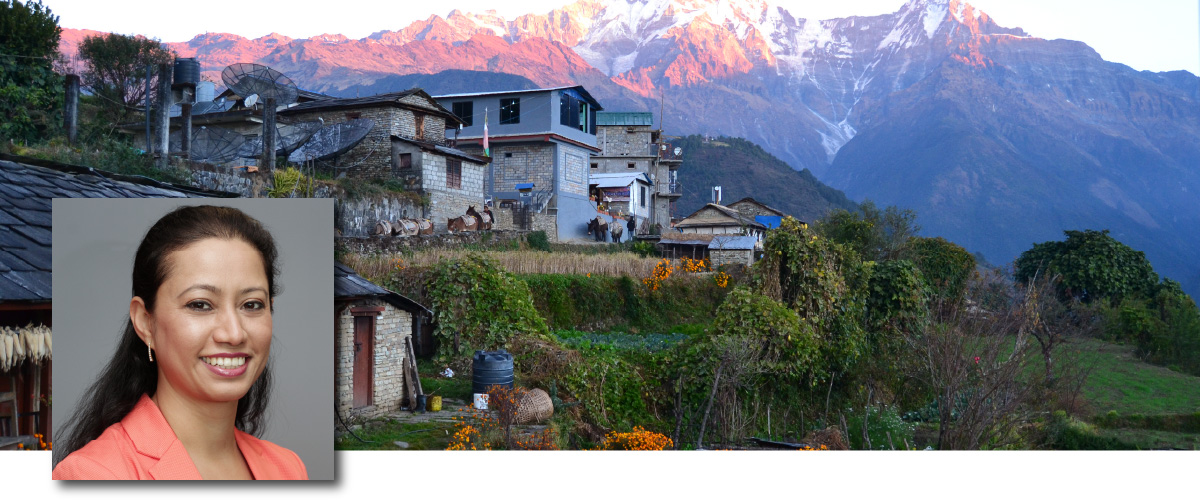Q&A with Richa Shivakoti

With Canada now the sixth country in which Senior Research Associate Richa Shivakoti has lived, migration was a natural choice for her research. But it was back when she was travelling through Nepal, her country of birth, that the idea for her PhD came into focus.
What led you to develop an interest in migration research?
After completing a master’s degree in the U.S., I wanted to work in the development sector so I returned to Nepal. I was able to travel the country and into remote areas. With almost 30 per cent of the country’s GDP coming from migrant remittances, I saw first-hand how dependent everything was on migration. Villages were empty of working-age men and there were reports of as many as three coffins containing the bodies of migrant workers arriving daily at the Nepal airport from various destination countries. This seeded my interest to do a PhD in Public Policy with a focus on temporary labour migration from the perspective of Asian-labour sending states, which I completed at the National University of Singapore.
Why has it been important to pursue a regional approach to your research?
My regional focus is on mobility within Asia, which has grown dramatically over time. Of all the international migrants in Asia, 60 per cent have come from countries within the Asian region. The volume itself makes it important to pursue a regional approach, but the many structural problems in the labour migration system as a whole are also causing major injustices. Since the 1970s, the forces of globalization and economic development led many Asian countries to send large numbers of temporary migrant workers to other countries. Their remittances have become valuable at the household level as well as the national level. But working abroad has become generational for many, and many migrant workers have been subject to a wide range of abuses and exploitation.
Because of their dependency on foreign remittances and the power imbalances between origin and destination countries, the labour-sending governments are unable to influence the working conditions for their nationals abroad. Further, the “sending” countries end up competing in a race to the bottom, accepting poor wages and working conditions for their nationals so as to not lose jobs to other countries.
That’s why a regional approach to labour migration governance is so important in South Asia and Southeast Asia and why I’m interested in researching progress in this area. The effectiveness of some of the Regional Consultative Processes, such as the Colombo Process and the Abu Dhabi Process, need to be improved upon so that labour-sending countries can bargain as a collective for better conditions and wages.
A regional understanding is key, but it’s also important to make comparisons between countries to uncover novel approaches that can be shared. For my PhD, I examined the labour migration governance and policies in Nepal and the Philippines and found that the Philippines, for example, adpoted innovative ways to extend its reach at destination countries to provide support to their migrant workers through their embassy premises. Some of these approaches are now being copied by other countries.
What insights from your research have surprised you most?
I was surprised to learn about the role of the middleman in connecting migrant workers to employment, and not just one, but several, each adding to the migrant’s expenses. Agents were often misleading migrants who would arrive in a country to find a job and pay arrangement that was completely different than what had been promised. I was also surprised to discover how interconnected these agencies were with governments in some countries. In one country, the labour minister was himself an owner of a recruitment agency (although he had handed control over to his son temporarily). With rampant conflicts of interest, how could there possibly be oversight for the protection of migrant workers?
I also found instances of ethical recruitment, but these agencies were working on placement for highly skilled migrants, like engineers, where the payoff for doing a good job on behalf of each individual was considerably higher. These agencies didn’t want to place domestic or construction workers because they could not guarantee their safety.
What do you hope to achieve with your work with CERC?
I bring to the CERC team both a focus on labour migration and a regional focus on South Asia/ Southeast Asia. South-South migration is much greater than South-North, yet most of the research literature addresses the latter flows and is produced by researchers based in the North. I hope to contribute an important South-South perspective, particularly by examining where the largest volume of migration is taking place, such as with the sending countries of India, Bangladesh, Nepal, Indonesia and the Philippines.
With so many diverse areas of specialization within CERC Migration, I will be interested in broadening my comparative analysis and finding common ground with colleagues working on different regions, such as Africa. African countries share many of the same problems with Asia because they too are sending migrants to countries where they have little power to influence labour laws and policies. I will also be interested in looking at the outcomes for Asian migrants here in Canada.
What is one outcome you would like to see achieved as a result of your research?
The most important thing to me as a researcher would be to help spur policy change to support migrant workers. Labour migration is here to stay for many countries, but there needs to be structural reforms at the country level to make it safer. Also, working abroad should not be the only opportunity for people to make a living. We can’t allow a system to continue where, generation after generation, people are forced to take dangerous routes to employment because there is nothing for them at home.
This interview has been edited and condensed for clarity and length.